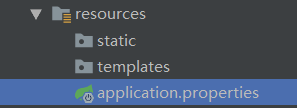1、新建项目,选择Create New Project

2、 下一步

3、下一步

4、下一步

5、下一步

6、 pom.xml暂时不用修改
<?xml version="1.0" encoding="UTF-8"?>
<project xmlns="http://maven.apache.org/POM/4.0.0" xmlns:xsi="http://www.w3.org/2001/XMLSchema-instance"
xsi:schemaLocation="http://maven.apache.org/POM/4.0.0 http://maven.apache.org/xsd/maven-4.0.0.xsd">
<modelVersion>4.0.0</modelVersion>
<parent>
<groupId>org.springframework.boot</groupId>
<artifactId>spring-boot-starter-parent</artifactId>
<version>2.1.6.RELEASE</version>
<relativePath/> <!-- lookup parent from repository -->
</parent>
<groupId>com.chenclass</groupId>
<artifactId>oauthclienttest</artifactId>
<version>0.0.1-SNAPSHOT</version>
<name>oauthclienttest</name>
<description>Demo project for Spring Boot</description>
<properties>
<java.version>1.8</java.version>
</properties>
<dependencies>
<dependency>
<groupId>org.springframework.boot</groupId>
<artifactId>spring-boot-starter-web</artifactId>
</dependency>
<dependency>
<groupId>org.springframework.boot</groupId>
<artifactId>spring-boot-starter-test</artifactId>
<scope>test</scope>
</dependency>
</dependencies>
<build>
<plugins>
<plugin>
<groupId>org.springframework.boot</groupId>
<artifactId>spring-boot-maven-plugin</artifactId>
</plugin>
</plugins>
</build>
</project>
7、创建3个包

8、在config包下添加类RestTemplateConfig
package com.chenclass.oauthclienttest.config;
import org.springframework.context.annotation.Bean;
import org.springframework.context.annotation.Configuration;
import org.springframework.http.client.ClientHttpRequestFactory;
import org.springframework.http.client.SimpleClientHttpRequestFactory;
import org.springframework.web.client.RestTemplate;
@Configuration
public class RestTemplateConfig {
@Bean
public RestTemplate restTemplate(ClientHttpRequestFactory factory) {
return new RestTemplate(factory);
}
@Bean
public ClientHttpRequestFactory simpleClientHttpRequestFactory() {
SimpleClientHttpRequestFactory factory = new SimpleClientHttpRequestFactory();
factory.setReadTimeout(5000);//ms
factory.setConnectTimeout(15000);//ms
return factory;
}
}
9、在global包下添加类GlobalOuathToken
package com.chenclass.oauthclienttest.global;
public class GlobalOuathToken {
public static String authorization ="Basic ZGVtb0NsaWVudDpkZW1vU2VjcmV0";
public static String token ="";
public static String refresh ="";
public static String token_type ="";
public static String POST_URLBAR = "http://127.0.0.1:8080/bar";
public static String POST_URLTOKEN = "http://127.0.0.1:8080/oauth/token";
public static String Get_URLUSER = "http://localhost:8080/admin";
}
10、在model包下添加类ApiToken和User
package com.chenclass.oauthclienttest.model;
public class ApiToken {
private String access_token;
private String token_type;
private String refresh_token;
private long expires_in;
private String scope;
public String getAccess_token() {
return access_token;
}
public void setAccess_token(String access_token) {
this.access_token = access_token;
}
public String getToken_type() {
return token_type;
}
public void setToken_type(String token_type) {
this.token_type = token_type;
}
public String getRefresh_token() {
return refresh_token;
}
public void setRefresh_token(String refresh_token) {
this.refresh_token = refresh_token;
}
public long getExpires_in() {
return expires_in;
}
public void setExpires_in(long expires_in) {
this.expires_in = expires_in;
}
public String getScope() {
return scope;
}
public void setScope(String scope) {
this.scope = scope;
}
}
package com.chenclass.oauthclienttest.model;
public class User {
private long userId;
private String userName;
private String password;
public User(long userId, String userName, String password) {
this.userId = userId;
this.userName = userName;
this.password = password;
}
public long getUserId() {
return userId;
}
public void setUserId(long userId) {
this.userId = userId;
}
public String getUserName() {
return userName;
}
public void setUserName(String userName) {
this.userName = userName;
}
public String getPassword() {
return password;
}
public void setPassword(String password) {
this.password = password;
}
}
11、修改TEST

package com.chenclass.oauthclienttest;
import com.chenclass.oauthclienttest.global.GlobalOuathToken;
import com.chenclass.oauthclienttest.model.ApiToken;
import org.junit.Test;
import org.junit.runner.RunWith;
import org.springframework.beans.factory.annotation.Autowired;
import org.springframework.boot.test.context.SpringBootTest;
import org.springframework.http.HttpEntity;
import org.springframework.http.HttpHeaders;
import org.springframework.http.HttpMethod;
import org.springframework.http.ResponseEntity;
import org.springframework.test.context.junit4.SpringRunner;
import org.springframework.util.LinkedMultiValueMap;
import org.springframework.util.MultiValueMap;
import org.springframework.web.client.HttpClientErrorException;
import org.springframework.web.client.RestTemplate;
import java.util.HashMap;
import java.util.Map;
@RunWith(SpringRunner.class)
@SpringBootTest
public class OauthclienttestApplicationTests {
@Autowired
private RestTemplate restTemplate;
private static String POST_URLBAR = "http://127.0.0.1:8080/bar";
private static String POST_URLTOKEN = "http://127.0.0.1:8080/oauth/token";
private static String Get_URLUSER = "http://localhost:8080/admin";
@Test
public void contextLoads() {
}
//(4)完整测试--使用token访问数据函数
@Test
public void gettoken() {
//headers
HttpHeaders requestHeaders = new HttpHeaders();
requestHeaders.add("Authorization", GlobalOuathToken.authorization);
// requestHeaders.add("Authorization", "Basic ZGVtb0NsaWVudDpkZW1vU2VjcmV0");
//body
MultiValueMap<String, String> requestBody = new LinkedMultiValueMap<>();
requestBody.add("grant_type", "password");
requestBody.add("username", "admin");
requestBody.add("password", "123456");
//HttpEntity
HttpEntity<MultiValueMap> requestEntity = new HttpEntity<MultiValueMap>(requestBody, requestHeaders);
RestTemplate restTemplate = new RestTemplate();
//post
try {
ApiToken apiToken = restTemplate.postForObject(GlobalOuathToken.POST_URLTOKEN, requestEntity, ApiToken.class);
GlobalOuathToken.token = apiToken.getAccess_token();
GlobalOuathToken.refresh = apiToken.getRefresh_token();
GlobalOuathToken.token_type = apiToken.getToken_type();
System.out.println(GlobalOuathToken.token );
}
catch (HttpClientErrorException e) {
e.getResponseBodyAsString();
// System.out.println(e.getRawStatusCode());
System.out.println(e.getStatusCode());
if(e.getRawStatusCode()==401)
{
System.out.println("401 出错 chen");
}
}
}
//(4)完整测试--使用token访问数据
@Test
public void resttesttoken1() {
if(GlobalOuathToken.token.equals(""))
{
gettoken();
}
HttpHeaders headers = new HttpHeaders();
headers.add("Authorization", GlobalOuathToken.token_type+" "+GlobalOuathToken.token);
// HttpEntity httpEntity = new HttpEntity(headers);
try {
// ResponseEntity<String> request = restTemplate.getForEntity(Get_URLUSER, String.class, httpEntity);
ResponseEntity<String> request = restTemplate.exchange(Get_URLUSER, HttpMethod.GET, new HttpEntity<Object>(headers), String.class);
System.out.println(request.getBody());
}
catch (HttpClientErrorException e) {
e.getResponseBodyAsString();
// System.out.println(e.getRawStatusCode());
System.out.println(e.getStatusCode());
if(e.getRawStatusCode()==401)
{
System.out.println("401 出错 chen");
}
}
}
}
12、修改端口

server.port=8090
12、开始测试
(1)启动前面编写的Oauthserver

(2)测试oauthclient的函数



































 2465
2465











 被折叠的 条评论
为什么被折叠?
被折叠的 条评论
为什么被折叠?








